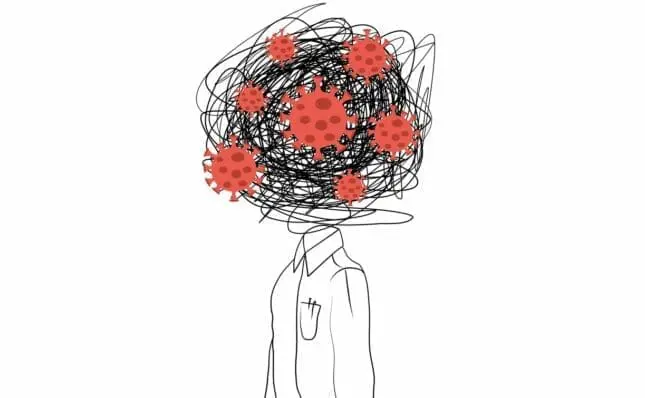Quandary: I work in a rural area and don’t have many options for referrals when it comes to clinical issues that aren’t my specialty. Recently, my client Andrew has started showing symptoms of obsessive-compulsive disorder (OCD). He’s struggled with anxiety for a while, but the pandemic seems to have been a tipping point for him. I’m finding it difficult to help him manage his fears and behaviors around getting sick and spreading the virus. What should I do?
Encourage Small Steps
It can certainly be challenging to treat a client whose anxiety is worsening, particularly when we’re in the middle of a pandemic that’s causing widespread fear, uncertainty, and potential danger to us and those we love. Being in a rural area without expert clinical consultation makes it much more difficult.
I’m not sure whether Andrew’s anxious brain has taken this potential danger to an extreme or if he’s actually developing OCD. Either way, I’d begin by educating him about his anxious brain, letting him know that his amygdala is doing exactly what it’s supposed to do: warn him of potential danger. The problem, I’d explain, is that his brain is telling him there’s a fire when there’s only smoke. It’s acting as though he has COVID and he’s already in danger.
Unfortunately, as we’ve all been quarantining, wearing face masks, and avoiding being near people, we’ve reinforced what our brain fears. The good news is that we can teach the brain to increase its ability to tolerate the discomfort of living in a pandemic. The way to help Andrew is by helping him tolerate his automatic fear thoughts and finding small ways for him to take reasonable risks, with precautions like hand-washing and mask-wearing, of course.
I’d remind Andrew that just because he thinks something doesn’t make it true. Then, he can get used to handling these as thoughts not-truths. Sometimes, I do an exercise where I pretend to be anxiety or OCD during the session and try to hook the client with their fears. In this case, I might say something to Andrew like, “You know, you could get COVID today. Maybe you already have it. What if you give it to someone after this session?” I’d want to coach Andrew into giving a non-response, something like, “This is just more of those bothersome thoughts. I can handle these. They’re actually a bit entertaining!”
Finally, I’d want to help him take some action steps, such as identifying ways he’s been staying safe, and finding ways to take reasonable risks, such as taking walks with friends outside or going to the grocery store instead of having food delivered.
Most importantly, I’d want to help Andrew understand that his brain is capable of learning how to live during a pandemic. But first, he needs to show it how by thinking and behaving in new ways.
Kimberly Morrow, LCSW
Erie, PA
Help Tell the Client’s Story
I believe Andrew’s anxiety may be protective to an extent. In this therapist’s position, I’d acknowledge that Andrew’s thinking may be keeping him safe, but that it’s also causing him unneeded stress and suffering. To address the issue, I’d use techniques from Acceptance and Commitment Therapy, including helping Andrew accept that even in taking risk-sensible COVID precautions, there’s no guarantee against contracting the virus.
I’d also help him notice and label the story, or thought, driving his OCD as a way to create distance between the thought and the compulsion, like, I am having the thought that having germs on my hands is going to make me sick. I’d want to interrupt these thoughts with ones like, At the same time, I haven’t left the house yet today, so I don’t need to wash my hands.
I’d work with Andrew to help him identify what risk-sensible guidelines might look like. Maybe it’s wearing a mask, washing his hands after being in public, or social distancing. I’d also help him practice gradual exposure to the outside world in gentle and safe ways. Meanwhile, we could use grounding and mindfulness techniques that allow him to lean into and make room for the physical sensations and experience of any anxiety that arises, so that he may release the stress and tension after processing it.
Sarah Magoffin, counsellor
Sydney, Australia
Normalize and Collaborate
If I was Andrew’s therapist, I’d start by doing a proper anxiety and depression assessment with him. The most effective ones only take about 10 minutes. I’d look at whether he’s experienced any significant events over the last few days or weeks—ones he felt prevented him from going about his normal business—that motivated him to seek treatment. If there was a pivotal event, what was the problem, and what did he suspect might be the outcome?
I’d also normalize Andrew’s anxiety, reinforcing that anxious behaviors are especially prevalent right now, but that this anxiety is usually manageable. I’d also ask what his treatment goals are, so we can collaborate on how to achieve them. I’d look for resilience resources and sources of support, whether in the form of family, friends, work, or hobbies.
The key here is to understand which of Andrew’s anxiety behaviors are most problematic—again, some anxiety is normal—and then collaborate to change them. Together, we’d establish tasks he could perform outside of sessions to change OCD behaviors. We’d make a hierarchy of obsessions and compulsions, whether it’s checking for contamination, excessive cleaning, fear of contact, or avoiding others. Other techniques, like doing body scans and progressive muscle relaxation, might also help.
Gillian Solomon, HCPC UK accredited BABCP member and CBTSA member
Somerset, UK
Try Something Fun
As an art therapist specializing in trauma and practicing in a rural area myself, I’d start by concentrating on two areas. First, Andrew and I would focus on the anxiety, and I’d explain to him how the body reacts to anxiety and stress. I usually tell clients that when we’re anxious, our cortisol levels go up. I’d ask Andrew to observe his body, notice how he’s sitting, and ask him to feel the tension in his muscles and observe where in his body he feels it. I’d tell him that research shows us one of the natural, cortisol-reducing hormones is oxytocin, and that the way to increase its production in the body is by knowing how to breathe.
Next, I’d recommend what I call the 7/11 method of breathing, where you breathe through the nose to the count of seven and exhale through the mouth to the count of 11. After practicing this together, I’d ask Andrew to do another body check and notice any changes in his muscles, and then practice it on his own at least twice daily.
The second area I focus on is changing associations. Let’s say Andrew’s anxiety gets revved up by seeing the surgical masks being used to protect against COVID, since they can conjure up scary thoughts and separate us from others. In this case, I’d try using art materials to decorate the mask. If Andrew uses gloves, we might decorate those, too. What was once an object that evoked stress now becomes an object of fun and personal identity. Andrew might even decorate several masks for different occasions.
If he wears gloves, I’d ask him to try finger-painting on a mirror. I’d bring the paints and the mirror to the session. After he’s done, I’d ask him to step back and look at the creation. This distancing effect allows the client to vicariously get their hands dirty without actually being dirty, and to regard the safety gloves in a new light. I’d have him write about this process, perhaps in poem of haiku form if he’d like. Afterward, I’d read it to him out loud. I’ve found that hearing the therapist—the other in the relationship—read your own words to you functions like mirror as well, creating a bond of connection and cementing the therapeutic relationship.
Hannah Sherebrin, registered art therapist
Israel
Educate Yourself
Clinicians who treat OCD are invaluable. Approximately two to three million adults and 500,000 children and teens in the U.S. have OCD, and it can take years for sufferers to finally get adequate treatment, namely cognitive behavioral therapy (CBT) with exposure and response prevention (ERP). Many also need medication for OCD treatment to have the greatest impact.
It’s wonderful that this therapist identified that Andrew’s anxiety has worsened during the pandemic and that his symptoms are consistent with OCD. Even though OCD may not be this therapist’s area of expertise, there are steps that can go a long way in helping Andrew get better.
Psychoeducation is a great place to start. I’d let Andrew know that his symptoms are consistent with OCD, and normalize what he’s experiencing. Stress can change and intensify anxiety symptoms, and this pandemic has been hard on everyone. For now, it’s important that Andrew understands what OCD is—stuck, repetitive, intrusive thoughts and compulsions that aren’t helping him stay safe or evaluate risk. He may feel justified in his fears by others or reports in the media. However, this therapist is noticing the hallmark of an anxiety disorder: not just helpful, normal anxiety, but unmanageable, intrusive thoughts and compulsions. It’s likely that Andrew is having difficulty living a happy life with this level of obsession.
I believe Andrew and his therapist can work through this together, even though the therapist isn’t an OCD expert. There are a variety of online resources at their disposal, including the International Obsessive-Compulsive Disorder Foundation’s website, which can teach them more about OCD and its treatment. There are also many great, free YouTube videos about OCD, including “The Noise in Your Head” by therapist Reid Wilson. I also highly recommend his podcast, The OCD Stories. There are also helpful workbooks for therapists interested in learning more about using CBT to treat OCD, including one that I coauthored with Kimberly Morrow titled CBT for Anxiety: A Step-by-Step Training Manual for the Treatment of Fear, Panic, Worry and OCD, which includes worksheets you can use immediately.
Elizabeth DuPont Spencer, LCSW-C
Erie, PA
Psychotherapy Networker
The editorial staff of Psychotherapy Networker comprises clinicians, journalists, and writers with a passion for creating a community where therapists gather and grow. Learn more on our About Us page.












